Oral Session
RF Pulse Design, Parallel Transmission & B1 Shimming
Joint Annual Meeting ISMRM-ESMRMB & ISMRT 31st Annual Meeting • 07-12 May 2022 • London, UK

09:15 |
0451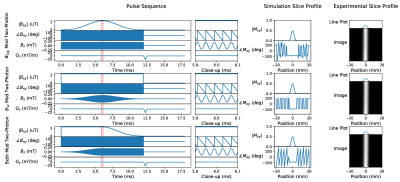 |
Pulsed Selective Excitation in Multiphoton MRI
Victor Han1, Jianshu Chi1, and Chunlei Liu1,2
1Electrical Engineering and Computer Sciences, University of California, Berkeley, Berkeley, CA, United States, 2Helen Wills Neuroscience Institute, University of California, Berkeley, Berkeley, CA, United States
When multiple RF fields are applied at different frequencies, multiphoton excitation can occur when the sums or differences of integer multiples of these frequencies equal the Larmor frequency. No RF at the Larmor frequency is required. In this work, we describe the general principles of multiphoton pulsed selective excitation, providing a formalized treatment with design examples and implementations on a 3T scanner with an additional homemade z-direction (Bz) coil. With the additional Bz coil, we demonstrate additional flexibility, where the same excitation can be accomplished in several different ways with the same pulse duration.
|
|
09:27 |
0452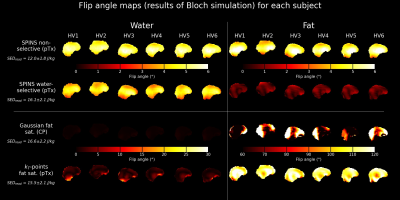 |
Fat suppression using dynamic parallel transmission at 7T: application to whole-brain CEST MRI
Simon Lévy1, Jürgen Herrler2, Andrzej Liebert1, Katharina Tkotz1, Moritz S. Fabian2, Christian Eisen1, Michael Uder1, David Grodzki3, Moritz Zaiss2, and Armin M. Nagel1,4
1Institute of Radiology, University Hospital Erlangen, Friedrich-Alexander-Universität Erlangen-Nürnberg (FAU), Erlangen, Germany, 2Department of Neuroradiology, University Hospital Erlangen, Friedrich-Alexander-Universität Erlangen-Nürnberg (FAU), Erlangen, Germany, 3MR Application Predevelopment, Siemens Healthcare, Erlangen, Germany, 4Division of Medical Physics in Radiology, German Cancer Research Center (DKFZ), Heidelberg, Germany
Fat signal can cause strong artifacts in MR images and/or bias measurements such as in Chemical Exchange Saturation Transfer (CEST) where metabolites peaks are reduced. At 7T, the signal-to-noise ratio and the peak separation are increased but the Specific Absorption Rate (SAR) constraints too, limiting the use of fat suppression pulses. Parallel transmit dynamic pulses for fat saturation (using kT-points) and water-selection (using a Spiral Non-Selective trajectory) were implemented for a whole-brain CEST protocol and optimized to reduce SAR compared to the standard circularly-polarized approach. Results showed high improvements in flip angle homogeneity and fat suppression efficiency, with reduced SAR.
|
|
| 09:39 | 0453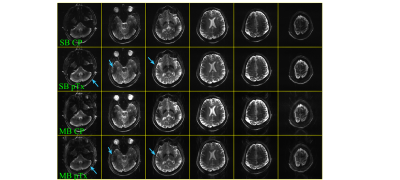 |
Simultaneous Multislice pTx for Readout-Segmented Diffusion Imaging at 7 T
Sydney Nicole Williams1, Iulius Dragonu2, Belinda Ding1,2, Patrick Liebig3, and David A. Porter1
1Imaging Centre of Excellence, University of Glasgow, Glasgow, United Kingdom, 2Siemens Healthcare Ltd. United Kingdom, Frimley, United Kingdom, 3Siemens Healthcare GmbH, Erlangen, Germany
This abstract addresses the challenges of 7T diffusion MRI associated with shorter T2/T2* and inhomogeneous B1+ field by implementing simultaneous multislice (SMS) parallel-transmit (pTx) slice-by-slice shimming in a readout-segmented diffusion-weighted sequence, RESOLVE. The benefits of pTx were compared to conventional single-transmit circularly polarized (CP) mode both with and without SMS using a matched high-resolution diffusion protocol in the same healthy volunteer. Slice-by-slice shimming significantly improves signal homogeneity while SMS opens the door for improved scan efficiency. The simplicity of slice-by-slice shimming and sequence integration makes this a practical solution for routine 7T imaging.
|
|
| 09:51 | 0454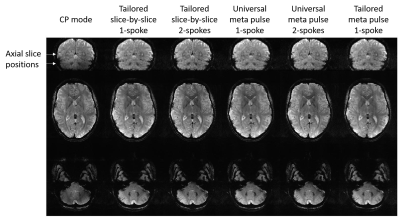 |
MetaPulse2D: methodology to enable universal slice specific spokes pulses in parallel transmission
Franck Mauconduit1, Vincent Gras1, Alexandre Vignaud1, and Nicolas Boulant1
1Paris-Saclay University, CEA, CNRS, BAOBAB, NeuroSpin, Gif-sur-yvette, France
When using a slice-by-slice RF shimming or multi-spokes pulses in 2D parallel transmission MRI, the solution is valid for a specific slice position and orientation. Here, we introduce a new pulse concept were the spoke coefficients and gradient blips are smooth functions of the slice position and orientation. We show that this design performs better than CP mode and equivalent to other designs. However, it enables to tilt or reposition slices without requiring additional optimization. This solution promotes signal smoothness through slices. Additionally, it can be pre-computed using the Universal Pulse concept or computed online using a tailored approach.
|
|
| 10:03 | 0455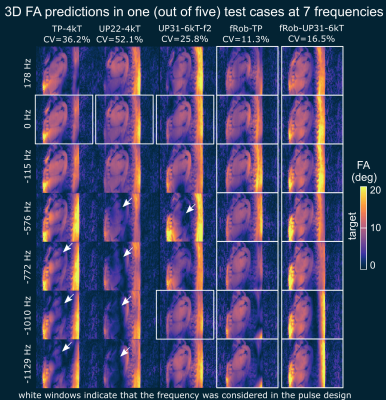 |
Towards frequency robust tailored and universal pulses in the human heart at 7T
Christoph Stefan Aigner1, Sebastian Dietrich1, Felix Krüger1, Max Lutz1, and Sebastian Schmitter1,2,3
1Physikalisch-Technische Bundesanstalt (PTB), Braunschweig and Berlin, Germany, 2German Cancer Research Center (DKFZ), Medical Physics in Radiology, Heidelberg, Germany, 3University of Minnesota, Center for Magnetic Resonance Research, Minneapolis, MN, United States
This work demonstrates the design and application of frequency robust, subject-tailored or universal, non-selective kT-point pulses to achieve a homogeneous flip-angle within the 3D human heart at 7T across a 1400Hz wide frequency range that includes water and six fat frequencies. Frequency robust universal pulses were computed offline based on 31 3D B1+-maps and could be used in time-critical situations for calibration-free 3D heart flip-angle homogenization. Experimental data at 7T validates the flip-angle predictions and demonstrates successful excitation of fat and water in the human heart at 7T.
|
|
10:15 |
0456 |
Rapid B1+ Mapping using a Sandwiched Train Saturated TurboFLASH Sequence at 7T
James L. Kent1, Ladislav Valkovic2,3, Iulius Dragonu4, and Aaron T. Hess1
1Wellcome Centre for Integrative Neuroimaging, FMRIB, Nuffield Department of Clinical Neurosciences, University of Oxford, Oxford, United Kingdom, 2Oxford Centre for Clinical Magnetic Resonance Research, University of Oxford, Oxford, United Kingdom, 3Department of Imaging Methods, Institute of Measurement Science, Slovak Academy of Sciences, Bratislava, Slovakia, 4Siemens Healthineers, Frimley, United Kingdom
Ultra-high field MRI with parallel transmit offers significant advantages but B1 transmit maps must be acquired to utilize its full potential. We designed and evaluated three new adaptations to a pre-saturation TurboFLASH B1+ mapping method. The proposed methods enabled significantly shorter TRs (on the order of 1 s), were insensitive to T1, and had comparable accuracy to the original method whilst maintaining the other desirable characteristics of the sequence. The method was shown to work in 3D allowing for volumetric B1+ maps to be acquired in 18 seconds.
|
|
10:27 |
0457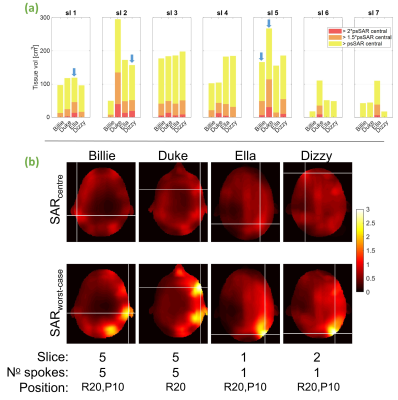 |
Inter-subject differences in SAR sensitivity to motion with parallel-transmit at 7T.
Alix Plumley1, Nathan Goodwin1, and Emre Kopanoglu1
1Cardiff University, Cardiff, United Kingdom
Specific absorption rate (SAR) is sensitive to head motion, especially in parallel-transmit (pTx) due to channel interference. It is known that SAR distribution varies according to subject anatomy. Here, we investigate whether SAR sensitivity to motion also depends on the subject. We designed quadrature-mode and pTx pulses at a centred position and evaluated them at 29 displaced positions. We compared the motion-induced SAR change across 4 body-models. We observed some variation across models, but local-SAR at least doubled in all models’ worst-cases. Our findings suggest that the safety concerns surrounding motion effects on SAR are relevant for various populations.
|
The International Society for Magnetic Resonance in Medicine is accredited by the Accreditation Council for Continuing Medical Education to provide continuing medical education for physicians.